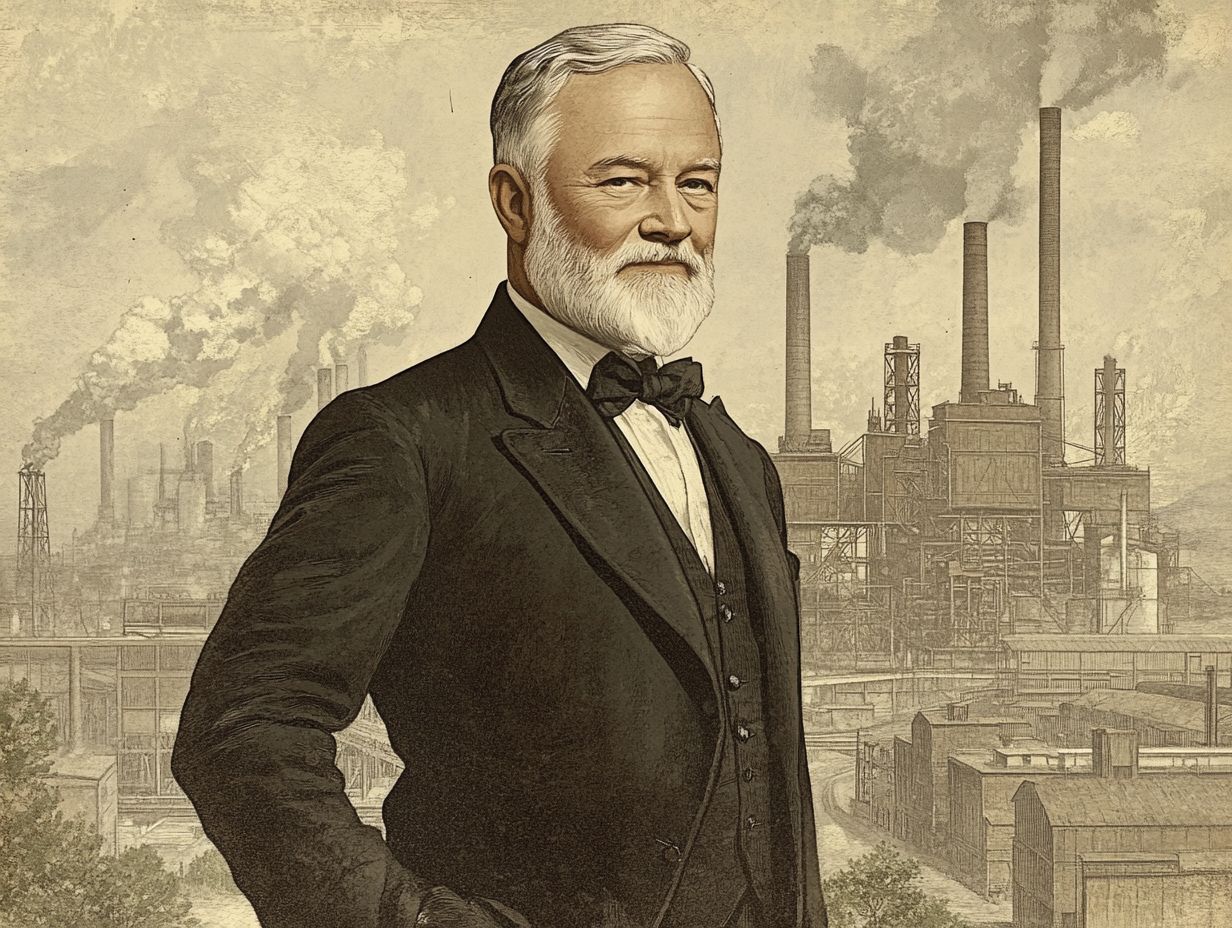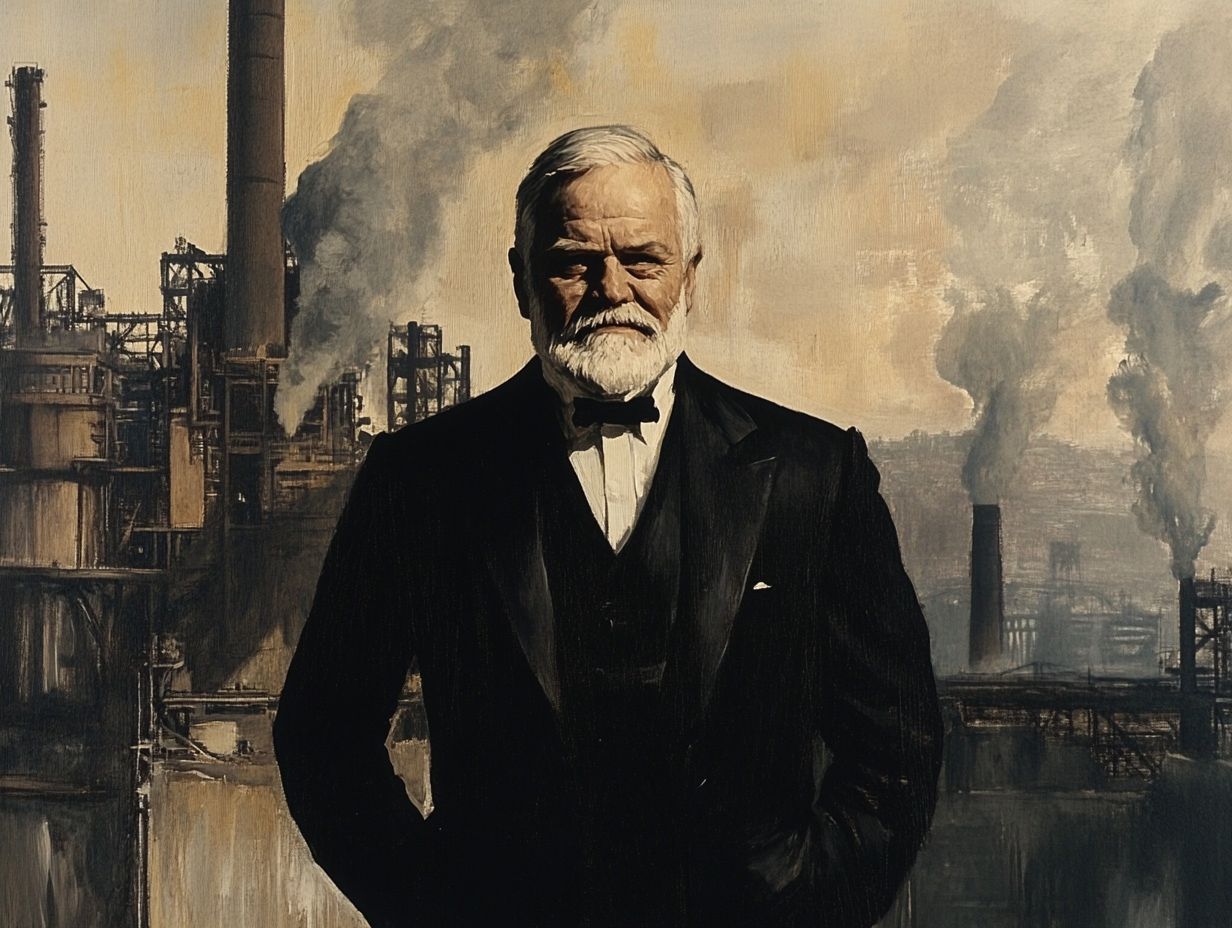From Rags to Riches: The Story of Andrew Carnegie
Andrew Carnegie’s journey from modest beginnings to one of America’s most influential industrialists is nothing short of captivating. It s a remarkable narrative woven with threads of ambition, resilience, and profound transformation.
Born into a humble family, he later immigrated to the United States, navigating early career obstacles to forge a thriving steel empire. Yet, his story extends beyond business success; Carnegie s philanthropic endeavors significantly shaped American society and industry, leaving a lasting impact.
However, his legacy is not without its controversies, raising essential questions about labor practices and worker relations. Delve into the multifaceted life of this extraordinary figure and uncover how his narrative continues to resonate in today’s world.
Contents
- Key Takeaways:
- Early Life and Background
- Rise to Success
- Philanthropy and Legacy
- Controversies and Criticisms
- Frequently Asked Questions
- Who is Andrew Carnegie?
- How did Andrew Carnegie rise from rags to riches?
- What is the significance of the phrase “from rags to riches” in relation to Andrew Carnegie?
- What were some of Andrew Carnegie’s major contributions to the steel industry?
- How did Andrew Carnegie use his wealth for philanthropic purposes?
- What is Andrew Carnegie’s legacy?
Key Takeaways:

- Andrew Carnegie’s humble beginnings as the son of Scottish immigrants shaped his determination and drive to become one of the wealthiest men in history.
- Carnegie’s success in the steel industry was due to his innovation and strategic business decisions, solidifying his role as a pioneer in American industry.
- Despite his controversies and criticisms, Carnegie’s immense philanthropic efforts and influence on American industry still shape society today.
Early Life and Background
Andrew Carnegie was born in 1835 in Dunfermline, Scotland, during an era known as the Gilded Age in America, which refers to a period of rapid economic growth in the late 19th century. His modest beginnings as the son of a poor weaver greatly shaped his future aspirations, instilling in him a deep understanding of social and economic issues and the relentless pursuit of the American Dream.
As an immigrant, his journey to the United States in the 1840s was marked by hard work and unwavering determination, ultimately paving the way for him to become the richest man in the world. He leveraged his skills as a telegraph operator and personal telegrapher for the Pennsylvania Railroad, turning ambition into unprecedented success.
Family and Childhood
Andrew Carnegie’s family endured significant hardships in Scotland, profoundly shaping his values and aspirations for a brighter future.
Growing up in Dunfermline during the industrial revolution, he was confronted with the stark realities of poverty and struggle from a young age. His parents toiled tirelessly in the weaving mills, striving to make ends meet, which instilled in him a robust work ethic and a remarkable sense of resilience.
The tight-knit family unit was a cornerstone of his upbringing, with each member rallying together in the face of financial constraints. These formative experiences in a socio-economic landscape rife with limited opportunities not only sculpted his ambitions for personal success but also ignited a lifelong commitment to philanthropy, driving him to give back to society and uplift others navigating similar challenges.
Immigration to the United States
In the 1840s, Andrew Carnegie made the bold decision to immigrate to the United States, driven by a desire for opportunity and a better life, leaving behind the struggles of his early years in Scotland.
The industrial revolution was reshaping America, creating a landscape brimming with potential for enterprising individuals like him. However, upon arrival, Carnegie encountered numerous challenges, including language barriers and economic hardships that were all too common for immigrants of that era.
The bustling urban life in cities like Pittsburgh might have felt overwhelming, yet it also offered prospects that ignited his determination. Starting as a child worker in a cotton factory, he developed a strong work ethic that would serve him well.
As time went on, he adapted by seizing every opportunity, forging connections, and mastering the intricacies of the burgeoning steel industry. In doing so, he embodied the resilience that countless immigrants displayed during this transformative period in American history, proving that perseverance can lead to extraordinary achievements.
Rise to Success
Your journey into success can be traced back to the foundational experiences in your early career. Much like Andrew Carnegie s tenure at the Pennsylvania Railroad, you would master the complexities of business and finance. This mastery would pave the way for establishing your own investment company.
With a strategic vision and a knack for innovative practices, such as the Bessemer process a method that makes steel production faster and cheaper you could find yourself ascending to remarkable heights. Perhaps, you would even become one of the wealthiest figures of your time.
Your contributions would not only shape the steel industry but also exemplify the power of owning all parts of the business, from production to sales, in driving growth and opportunity.
Early Career and Business Ventures

Carnegie’s early career was a tapestry woven with various roles that offered him invaluable business insights, particularly during his time at the Pennsylvania Railroad.
As a telegraph operator, he developed a sharp acumen for communication within a rapidly evolving industry. This understanding would later prove essential in his ventures. This experience not only refined his technical skills but also enabled him to forge connections that became invaluable as he ventured into other sectors, such as steel production.
His tenure in the railroad sector allowed him to grasp the intricacies of logistics and management. This ultimately shaped his approach to efficiency and innovation when he founded Carnegie Steel. These foundational experiences instilled in him the principles of strategic planning and operational excellence that would define his later successes.
Expansion into Steel Industry
Your expansion into the steel industry is your chance to make a mark. Embrace the Bessemer process for large-scale production and position yourself as a leader in this burgeoning field.
This groundbreaking method transforms steel manufacturing by converting molten iron into steel more efficiently and at a lower cost, making it a game changer.
As you delve deeper into this realm, you ll come to understand that controlling every stage of production is essential for success. By adopting a strategy of vertical integration, you ll own not only the steel mills but also the iron mines and railroads that supply raw materials and transport your finished products.
This comprehensive control slashes expenses and guarantees quality and timely delivery. It ultimately solidifies your dominance in an industry poised for explosive growth and transformation.
Philanthropy and Legacy
Andrew Carnegie’s legacy is intricately linked to his unwavering commitment to philanthropy, which he regarded as a moral duty of the affluent. His philanthropic endeavors gave rise to a multitude of public libraries and educational institutions, as well as the Carnegie Corporation.
These incredible initiatives showcase his strong belief in the equitable distribution of wealth and underscore the vital role of knowledge in fostering societal progress.
Donations and Contributions
Carnegie’s donations played a crucial role in establishing over 2,500 public libraries across the United States. This reflects his unwavering commitment to public education and access to knowledge.
These libraries became essential community hubs, offering countless individuals free resources and a welcoming space to nurture learning and creativity.
Carnegie also generously founded prestigious institutions, such as Carnegie Mellon University and the Carnegie Institution for Science. Both of these institutions continue to push the boundaries of education and scientific discovery to this day.
His support for cultural organizations, including Carnegie Hall and the Carnegie Museums, enriched the arts and sciences. This established a legacy that future generations can admire and expand upon.
Ultimately, his philanthropic vision transformed communities during his lifetime and laid the groundwork for ongoing advancements in education and culture.
Influence on American Industry
Andrew Carnegie’s influence on the steel industry was nothing short of revolutionary! It plays an important role in shaping industrial innovations and labor practices during a pivotal time in American history.
As you delve into the challenges of quick industrial growth, you’ll notice that Carnegie’s choices often revealed a delicate balance between maximizing profits and acknowledging the evolving rights of workers.
Throughout this tumultuous period, the steel magnate engaged with various workers’ advocates, many of whom were dedicated to improving working conditions and securing fair wages. His well-known clash during the Homestead Strike clearly shows the tension between industrial progress and labor rights, prompting essential questions about the obligations of affluent industrialists.
This interaction not only illuminates the harsh realities faced by laborers but also underscores the broader implications of how companies are run and its far-reaching impact on society.
Controversies and Criticisms

Despite his philanthropic legacy, Andrew Carnegie encounters significant controversies and criticisms, particularly concerning his business practices and the Homestead Strike.
These events question how he treated workers and unions, prompting a deeper examination of his impact on both industry and society.
Labor and Business Practices
Carnegie’s labor practices have faced considerable scrutiny, especially regarding the Homestead Strike. This conflict starkly illuminated the complexities of industrial labor relations during the Gilded Age.
The conflict at the Homestead steel mill not only revealed the grim realities of working conditions but also showcased the starkly contrasting philosophies of capital and labor during an era of rapid industrialization.
Carnegie and his management adopted a firm stance against unionization, resorting to ruthless tactics to suppress worker dissent and maintain tight control over production. This approach culminated in a brutal confrontation that resulted in loss of life and significant turmoil.
Feeling betrayed by management that once promised improved conditions, workers united to demand fair wages and safer workplaces. This moment was crucial for labor history!
These events underscored the tensions within Carnegie’s organization, highlighting how his relentless pursuit of profit often came at the expense of employee rights and welfare, ultimately shaping future labor legislation and influencing public sentiment.
Relationship with Workers and Unions
The relationship between Andrew Carnegie and his workers is a fascinating tapestry of cooperation and conflict, particularly when it comes to labor unions and the advocates for workers’ rights.
This intricate dynamic mirrors the broader tensions of the Industrial Revolution, as many workers sought improved wages, better working conditions, and job security in the midst of a rapidly evolving economic landscape.
Carnegie, often hailed as a titan of industry, initially lent his support to certain labor reforms and established programs that appeared to benefit his workforce. However, as unions gained strength and began to assert their influence, a significant rift emerged.
The infamous Homestead Strike of 1892 perfectly encapsulates these tensions, revealing the violent confrontations that erupted when workers stood against wage cuts and the erosion of their power.
This moment serves as a crucial turning point in the ongoing struggle between industrial leaders and labor organizations.
Frequently Asked Questions
Who is Andrew Carnegie?
Andrew Carnegie was a Scottish-American industrialist, businessman, and philanthropist. He was one of the richest men in the world during the late 19th and early 20th century and is best known for his role in the expansion of the steel industry in the United States.
How did Andrew Carnegie rise from rags to riches?

Andrew Carnegie was born into a poor family in Scotland. He immigrated to the United States as a child and started working at a young age as a telegraph messenger.
Through hard work and smart investments, he became one of the wealthiest men in the world.
What is the significance of the phrase “from rags to riches” in relation to Andrew Carnegie?
The phrase “from rags to riches” captures Andrew Carnegie’s journey from a humble background to great wealth. It showcases his determination, hard work, and entrepreneurial spirit.
What were some of Andrew Carnegie’s major contributions to the steel industry?
Andrew Carnegie changed the steel industry with new, efficient production methods like the Bessemer process, which made steel production faster and cheaper.
He also controlled all parts of production through vertical integration, ensuring higher profits.
How did Andrew Carnegie use his wealth for philanthropic purposes?
Carnegie was passionate about using his wealth to improve society. He donated to public libraries, universities, and various educational initiatives.
What is Andrew Carnegie’s legacy?
Carnegie’s legacy is significant. He is remembered as a successful industrialist and for his lasting contributions to steel and philanthropy.
His life and achievements continue to inspire people around the world.






